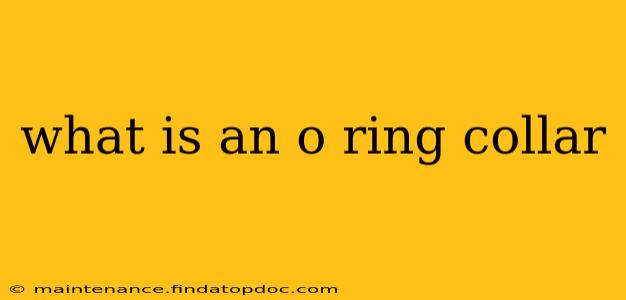An O-ring collar, also sometimes referred to as an O-ring seal or simply an O-ring, is a simple yet incredibly versatile mechanical seal. It's a toroidal (doughnut-shaped) ring made from a variety of elastomeric materials, designed to create a tight seal between two or more mating surfaces. This prevents leakage of fluids, gases, or even dust, making them critical components in countless applications across various industries. Understanding their function, materials, and applications is crucial for anyone working with machinery or engineering designs.
What are O-Rings Made Of?
The material composition of an O-ring significantly impacts its performance and suitability for a given application. Common materials include:
- Nitrile (Buna-N): A widely used material offering a good balance of cost-effectiveness, durability, and resistance to oils, fuels, and many chemicals. However, it's not suitable for high temperatures or certain solvents.
- Silicone: Excellent resistance to high and low temperatures, making it ideal for extreme environments. It also exhibits good chemical resistance but can be more expensive than nitrile.
- Viton (FKM): Known for its exceptional resistance to a wide range of chemicals, solvents, and high temperatures. A premium choice for demanding applications.
- EPDM (ethylene propylene diene monomer): Offers excellent resistance to ozone, weathering, and many chemicals, making it suitable for outdoor applications.
- Fluorosilicone: Combines the benefits of silicone's temperature resistance with the enhanced chemical resistance of fluorocarbons.
How Does an O-Ring Collar Work?
An O-ring creates a seal by utilizing its elasticity and the compression force applied when it's installed into a groove. When compressed between two mating surfaces, the O-ring's inherent elasticity conforms to the irregularities of those surfaces, effectively plugging any gaps and preventing leakage. The effectiveness of the seal depends on factors like the material of the O-ring, the surface finish of the mating parts, the compression force, and the pressure and temperature of the fluid being sealed.
What are the Different Types of O-Ring Collars?
While the basic design is consistent, variations exist to accommodate specific applications:
- Standard O-Rings: The most common type, used in a wide range of applications.
- Back-up Rings: Often used in conjunction with standard O-rings to provide additional support and prevent extrusion under high pressure.
- Metric O-Rings: Manufactured to metric dimensions.
- Specialty O-Rings: These include O-rings with specialized materials, coatings, or shapes for specific applications (e.g., high-temperature applications or those requiring enhanced chemical resistance).
What are the Applications of O-Ring Collars?
O-ring collars are ubiquitous across various industries and applications, including:
- Automotive: Sealing engine components, fuel systems, and transmissions.
- Aerospace: Sealing critical components in aircraft and spacecraft.
- Hydraulics and Pneumatics: Sealing fluid power systems.
- Industrial Machinery: Sealing pumps, valves, and other equipment.
- Medical Devices: Used in various medical devices requiring leak-proof seals.
What are the Common Problems with O-Ring Collars?
Despite their reliability, certain issues can compromise their effectiveness:
- Improper Installation: Incorrect installation can damage the O-ring or prevent it from sealing properly.
- Material Incompatibility: Using an O-ring made of a material incompatible with the fluid being sealed can lead to swelling, degradation, or failure.
- Excessive Compression: Over-compressing the O-ring can deform it and compromise the seal.
- Insufficient Compression: Insufficient compression can leave gaps, allowing leakage.
- Abrasion and Wear: Friction and wear can degrade the O-ring over time.
How to Choose the Right O-Ring Collar?
Selecting the appropriate O-ring collar requires careful consideration of several factors:
- Fluid Compatibility: The O-ring material must be compatible with the fluid being sealed.
- Temperature Range: The O-ring must be able to withstand the operating temperature range.
- Pressure: The O-ring must be able to withstand the operating pressure.
- Size and Dimensions: The O-ring must be the correct size for the application.
- Surface Finish: The surface finish of the mating parts must be suitable for a proper seal.
By understanding the nuances of O-ring collars, users can ensure proper selection, installation, and maintenance, maximizing their effectiveness and longevity across various applications. Remember, a seemingly simple component like an O-ring plays a vital role in ensuring the safe and efficient operation of countless systems.
